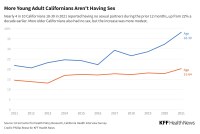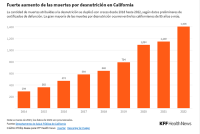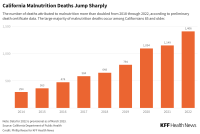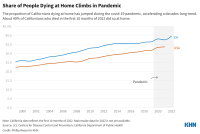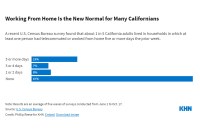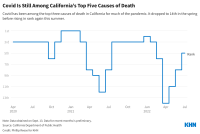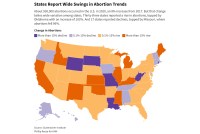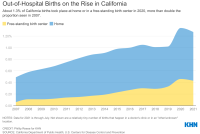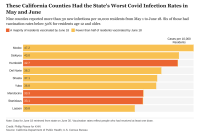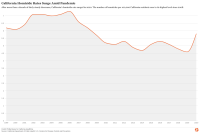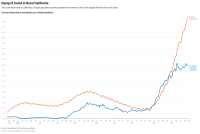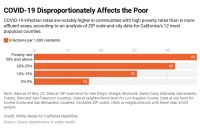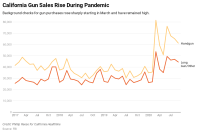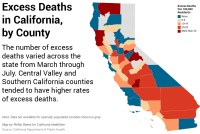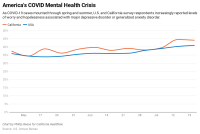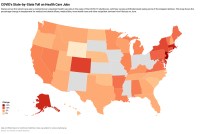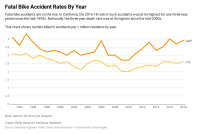Por qué los adultos jóvenes tienen menos sexo que el que tuvieron sus padres
La cantidad de adultos jóvenes que no tienen relaciones sexuales ya estaba aumentando antes de que covid-19 hiciera que las citas fueran más difíciles y riesgosas.
Young People Are Having Less Sex Than Their Parents Did at Their Age. Researchers Explore Why.
The percentage of young adults not having sex was rising even before covid made dating harder. Data and research suggest economic precarity, technology, and the warping effects of porn on sexual attitudes may play a role.
Aumenta el número de californianos mayores que muere por desnutrición
Las muertes atribuidas a la desnutrición aumentaron más del doble, de unas 650 en 2018 a aproximadamente 1,400 en 2022, según datos preliminares de certificados de defunción del Departamento de Salud Pública estatal.
The Rate of Older Californians Dying of Malnutrition Has Accelerated
Californians 85 and older are especially susceptible to malnutrition. They accounted for almost three in five malnutrition deaths in the state last year.
More Californians Are Dying at Home. Another Covid ‘New Normal’?
The proportion of Californians dying at home, rather than in a hospital or nursing home, accelerated during the pandemic, a trend that has outlasted the rigid lockdowns linked to the initial shift.
A Work-From-Home Culture Takes Root in California
New U.S. Census Bureau data shows a large segment of Californians are working from home for part or all of the week. Researchers say the shift will ripple through the broader economy in ways big and small.
Covid Still Kills, but the Demographics of Its Victims Are Shifting
Californians were far less likely to die from covid in the first seven months of 2022 than during the first two years of the pandemic. Still, the virus remained among the state’s leading causes of death in July, outpacing diabetes, accidental death, and a host of debilitating diseases. We break down who’s at risk.
Three-Year Abortion Trends Vary Dramatically by State
About 930,000 abortions occurred in the U.S. in 2020, an 8% increase from 2017. But that nationwide figure belies dramatic variation among states — disparities expected to magnify in the wake of the Supreme Court’s decision to strike down Roe v. Wade.
California Sees Dramatic Decline in Child Homicide Victims. What’s Changed?
Bucking the alarming spike in overall homicides in recent years, the homicide rate involving young children is down 70% in California from three decades ago. The nation has seen a parallel, albeit slower, decline.
Home Births Gain Popularity in ‘Baby Bust’ Decade
Over the past decade, California has seen a sustained rise in the proportion of people who opt to give birth at home or in midwife-run birthing centers rather than in a hospital. Covid has further fueled that trend.
California’s Highest Covid Infection Rates Shift to Rural Counties
As vaccination rates rise across the state, the overall numbers of covid cases and deaths have plunged. But health officials are still reporting nearly 1,000 new cases and more than two dozen deaths a day. So, where does covid continue to simmer in California? And why?
Homicides Surge in California Amid Covid Shutdowns of Schools, Youth Programs
California endured a brutal spike in homicides in 2020 across large swaths of the state, registering the largest year-over-year increase in victims in three decades. Experts cite as one significant factor a rise in gang violence fueled by pandemic shutdowns of schools, sports leagues and programs for at-risk youth.
How Covid Has Changed Our Movement, as Revealed by Your Cellphone
Californians are venturing out to shop, dine and work far more now than a year ago, when state officials issued the first sweeping stay-at-home order. But we’re still sticking to home way more than before the pandemic, according to mobile phone tracking data.
California’s Rural Counties Endure a Deadly Covid Winter
In the past two months, covid-related infection and death rates have jumped exponentially in California’s least populated counties. The winter surge has scarred corners of the state that went largely unscathed for much of 2020.
High-Poverty Neighborhoods Bear the Brunt of COVID’s Scourge
COVID infection rates in California are consistently higher in low-income neighborhoods than more affluent areas, according to an analysis by ZIP code. Our findings underscore the heightened risks borne by millions of low-wage workers whose jobs are deemed essential.
As Anxieties Rise, Californians Buy Hundreds of Thousands More Guns
Gun sales are surging in California, where handgun-related FBI background checks this spring and summer were up 83% over 2019. Whether pro or con on gun control, experts agree the trend has been fueled by pandemic-related unrest.
California’s Deadliest Spring in 20 Years Suggests COVID Undercount
California’s death count for the first five months of the pandemic was 13% higher than average for the same period during the prior three years. Subtract the deaths officially attributed to COVID-19 and experts say that still leaves scores of “excess” deaths among people of color that likely were mistakenly excluded from the coronavirus death tally.
Feeling Anxious and Depressed? You’re Right at Home in California.
In a series of July U.S. Census Bureau surveys, nearly half of California adult respondents reported levels of anxiety and gloom typically associated with diagnoses of generalized anxiety disorder or major depressive disorder, a stunning figure that rose through the summer alongside the menacing spread of the coronavirus.
Dental and Doctors’ Offices Still Struggling with COVID Job Loss
Newly released employment data underscores the lingering toll the pandemic has taken on a range of outpatient services in California and across the U.S., from pediatric and family medical practices to dental offices, medical labs and home health care.
Bike Fatalities Are On The Rise
More than 450 cyclists died in traffic accidents in California from 2016 through 2018, marking the highest three-year death rate in 25 years. Among the factors at play: more cars on roads, distracted driving and a pronounced consumer shift toward SUVs.




